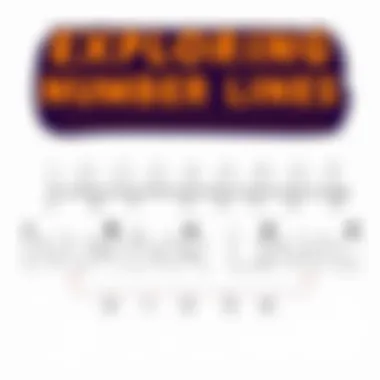Exploring Printable Number Lines for Effective Learning


Intro
In the world of education, the significance of foundational concepts can't be stressed enough. Children often find themselves wrestling with numbers, and that’s where tools like printable number lines come into play. These graphics not only simplify the complexities of counting and arithmetic, but they also make learning a more engaging endeavor for young learners.
Printable number lines serve as visual aids that can transform how kids perceive mathematics. They allow students to grasp abstract ideas and see the connections between numbers. This article examines the role of number lines in cultivating numeracy skills among children while also offering practical insights into their various applications in educational settings.
As we venture into the depths of printable number lines, we will explore different types, their uses, and ways to effectively implement them in diverse learning routines. More than a mere classroom prop, number lines can create a positive learning environment, making math feel less daunting and more accessible.
The exploration ahead promises to be comprehensive, providing not just theoretical knowledge but also actionable tips for parents and educators. Whether you’re looking to enhance teaching methods or enrich a child's learning experience, number lines could be the catalyst for success.
Foreword to Printable Number Lines
In the realm of early mathematics education, printable number lines serve as a bridge connecting abstract concepts with tangible understanding. When children first encounter numbers, they often struggle to grasp their values and relationships. Printable number lines present a visual and interactive method to engage with these concepts, making learning more accessible and enjoyable.
Definition and Purpose
A printable number line is a visual representation of numbers arranged in a linear fashion. It typically includes evenly spaced intervals and can range from whole numbers to fractions and decimals. The purpose of a number line transcends mere representation; it acts as a vital tool in helping students understand the continuum of numerical values. In essence, it embodies numbers in a format that is both engaging and informative, allowing children to visualize mathematical relationships.
Using these number lines, kids can easily grasp essential skills such as counting, addition, and subtraction. For example, if a child wants to find the sum of 2 and 3, they can physically count the spaces between these two points on the number line. This hands-on experience nurtures a deeper comprehension of mathematical operations, reinforcing learning through visual aids.
Historical Context
The concept of number lines can be traced back to various cultures throughout history, notably in ancient civilizations that utilized comparative measures in trade and astronomy. The Greeks, for instance, began laying the groundwork for mathematical visualization long before number lines as we know them emerged. However, it wasn’t until the 17th century that formalized number lines took shape, thanks to mathematicians who sought to provide clearer methods of representing numbers.
In modern education, number lines have gained recognition as essential tools that support children’s learning journeys. Teachers and educators now embrace these resources as integral to developing foundational math skills. Understanding the historical significance of number lines enhances our appreciation of their role today, showcasing a legacy of logical progression and learning that continues to evolve.
"Number lines are not just tools; they are pathways to mathematical mastery."
In summary, printable number lines are more than mere sheets of paper with numbers; they are powerful educational resources. Through the lens of both definition and historical context, we begin to appreciate their vital role in facilitating young learners’ exploration of mathematics.
Types of Number Lines
Number lines serve as foundational tools in mathematics education, especially for young learners. They help visualize numerical relationships and operations, making abstract concepts more tangible. Recognizing the different types of number lines is crucial for maximizing their educational impact. This section will cover the primary categories, their purposes, and how they can enhance a child's mathematical understanding.
Basic Number Lines
Basic number lines typically display numbers in a linear sequence, providing a straightforward reference for counting. They usually begin at zero and extend in both directions, allowing students to explore positive and negative numbers. One of the key elements of basic number lines is their simplicity; the absence of additional markings or distractions helps children focus on core numerical concepts.
For example, a basic number line can be a great tool for introducing addition and subtraction to early learners. When adding, children can visualize moving to the right; and for subtraction, they can think of moving to the left. This visualization significantly aids retention and understanding.
"Number lines break down barriers to understanding math, giving students a visual pathway to grasp concepts."
Vertical vs. Horizontal Formats
Number lines can be presented in both vertical and horizontal layouts, each offering unique advantages. Horizontal number lines are most commonly used in educational settings because they align with the way children traditionally read—left to right. This format allows for easy tracking of number sequences and is especially beneficial during classroom activities.
On the other hand, vertical number lines can be particularly advantageous when dealing with certain mathematical concepts, such as graphing or when integrating number lines into classroom displays. They might fit better on whiteboards or in areas with limited horizontal space. The choice of format can depend on the learning environment and the specific math skills being taught.
Interactive Number Lines
Digital Formats
Digital number lines bring an exciting and modern approach to the learning process. These formats can be used on tablets, smartphones, or computers, allowing for interactive elements that engage children in ways traditional methods might not. One notable characteristic of digital formats is their adaptability; educators can easily modify them to suit various learning needs and levels. For example, there are apps that allow students to manipulate numbers on the line, providing them hands-on experience.
Digital number lines also often offer instant feedback. Children can see their own progress as they practice, making learning both fun and effective. However, one must consider that not all students will have regular access to digital devices, which can limit usage in certain contexts.
Printable Formats


Printable formats present a more traditional and accessible means of incorporating number lines into learning. One of their key characteristics is simplicity—they can be easily printed and customized for different learning activities. This format allows for frequent hands-on practice without relying on technology.
Another advantage of printable number lines is their versatility; teachers can personalize them with symbols, colors, or specific numbers relevant to a lesson plan. But while they’re highly accessible, one downside is that they lack the interactive features found in digital alternatives. This might limit engagement for some students who learn best through active participation.
Educational Applications of Number Lines
The world of mathematics can sometimes feel daunting for children. However, printable number lines have emerged as significant tools in making numerical concepts more accessible. Their application spans various learning environments, giving kids the chance to visualize their calculations and grasp concepts that would otherwise seem abstract. By weaving these tools into everyday interactions, teachers and parents can enhance a child's comfort and confidence with numbers. This section explores several vital educational applications of number lines, looking in-depth at how they bolster numeracy, clarify mathematical ideas, and refine problem-solving skills.
Supporting Numeracy Skills
When it comes to supporting numeracy skills, printable number lines provide a sturdy platform. It allows students to see numbers in a linear fashion, helping them understand sequences, increases, and decreases intuitively. For instance, a child might struggle with understanding what it means to count by twos or fives, but a number line visually lays that out. Each hop along the line represents a consistent increase, making the concept tangible. Children are encouraged to physically mark and trace their own number lines, turning what could be a simple mnemonic device into an interactive learning tool. The tactile aspect of using a pencil or finger on the line can make all the difference when grasping foundational concepts.
Visualizing Mathematical Concepts
Visual representations of mathematics often clarify concepts that can feel overwhelming in their abstract form. Number lines lend themselves beautifully to illustrating various operations:
Addition and Subtraction
Addition and subtraction are fundamental operations every child encounters. When children visualize addition on a number line, they can see how numbers stretch or move outwards from a starting point. For example, if a child needs to add 3 + 4, they can start at the number three and make four hops to land on the number seven. Likewise, subtraction can be understood as moving backward on the line, pulling away from a number. This representation solidifies understanding because it engages the child in hands-on practice. The ease of movement along the line supports a child's ability to conceptualize these operations further, making it a highly beneficial choice for this article.
Multiplication and Division
While adding and subtracting are the basics, the journey takes an interesting turn when introducing multiplication and division. Multiplication can be illustrated as repeated addition. When kids know that multiplying three by four means adding three four times, they can plot out their jumps on the number line. This visual makes multiplication more digestible.
Conversely, division takes a different approach. It can be seen as breaking down a number into equal parts. When kids understand the concept of sharing equally, the number line opens up a visual channel to execute division practically. Number lines thus become a popular tool among educators for demonstrating these operations, serving both as an aid and a reinforcement of learning.
Fractions and Decimals
It's no secret that fractions and decimals often baffle students new to them. Printable number lines uniquely cater to these mathematical areas by allowing students to visualize fractions as segments on the line. For example, if students need to understand that one-half is halfway between zero and one, a number line clarifies this visually. Children can see that each fraction brings them a step closer to closure with a whole while grasping their relative sizes.
Decimals follow this same logic but often introduce children to the nuances of value. When learners place 0.25 on a number line, they begin to associate decimals not just as numbers, but as placements in relation to whole numbers. The interactive aspect encourages exploration and creative understanding of numeracy through visual representation.
Enhancing Problem Solving
As children dive into multi-step arithmetic problems, number lines can be their ally. They can jot down their calculations in a sequential manner, creating a clear path from start to finish. This helps in both increasing cognitive function as they track their thoughts and bolstering their confidence in their problem-solving capabilities. The idea is simple—break down larger problems into manageable pieces and diagram them visually. This not only makes the math approachable but also enhances logical thinking by encouraging students to think critically about their approach to each problem.
In summary, the applications of printable number lines in education are broad-ranging and invaluable. They provide more than just a way to display numbers; they create environments in which children can thrive mathematically.
Creating Customized Number Lines
Customizing number lines tailors the learning experience for children, helping them engage and understand mathematical concepts at their own pace. By creating number lines that reflect individual needs, parents and educators can effectively assist in clarifying numerical relationships, making the learning both personal and enjoyable. It's akin to having a tailor-fitted suit – it just fits better.
Materials Needed
Before embarking on creating customized number lines, it’s important to gather the necessary materials. Here’s what you’ll need:
- Paper or Cardstock: Choose sturdy options to ensure longevity. For more interactive options, you can use laminated sheets.
- Markers or Crayons: Vibrant colors help in distinguishing various segments or numbers on the number line.
- Ruler: For precise measurements.
- Scissors: If you plan to make any cuts.
- Adhesive: This might be glue or tape, depending on how you choose to assemble your number line.
- Digital Tools (Optional): Tools like Google Slides or Canva can be great for designing number lines online.
Steps to Design a Number Line
Creating your own number line is simpler than it appears. Here’s a straightforward approach to ensure it works well:
- Determine the Range: Decide the range you want your number line to cover. Are we focusing on numbers 1 to 20, or perhaps extending to 100?
- Choose the Format: Will it be horizontal or vertical? This can depend largely on the space available and personal preferences.
- Draw the Line: Use a ruler to draw a straight line across your paper. This should be about an inch wide for clarity.
- Mark the Intervals: Decide how many intervals you want between the numbers. For example, increments of two or five can be useful based on the child’s learning stage.
- Label the Numbers: Clearly write the numbers corresponding to each interval. For added personalization, you might add pictures or symbols that could help push understanding further.
- Decorate and Customize: Encourage creativity! Kids can add drawings or stickers to make it uniquely theirs, reinforcing their connection with the learning tool.
Considerations for Different Learning Styles
When customizing number lines, keeping in mind the learning styles of different children is essential. Here are some considerations:
- Visual Learners: They benefit from colorful and illustrative designs. Adding graphics or thematic elements can cement their understanding.
- Kinesthetic Learners: For them, a tactile number line, perhaps with physical objects at each mark, can enhance learning. Consider using pebbles or coins that they can move along the line.
- Auditory Learners: Incorporating songs or rhythm-based counting alongside number lines creates a multi-sensory experience.
- Logical Thinkers: These learners may prefer a structured approach. A clean and organized number line with clear markings is beneficial.


In summary, the customization of number lines is not just about aesthetics. It involves understanding the unique needs of each learner, allowing for a richer educational experience.
"Tailored learning resources foster independence and confidence in children as they navigate mathematical concepts."
For further reading on number lines and learning styles, you can visit Wikipedia, which dives into the world of mathematical understanding.
Incorporating Number Lines into Learning Routines
Incorporating number lines into daily learning routines is crucial for fostering a solid foundation in math for children. Number lines serve as visual aids that not only facilitate understanding but also make abstract concepts more tangible. The use of these tools in educational settings helps to bridge the gap between theoretical knowledge and practical application, reinforcing various mathematical skills. By embedding number lines into daily activities, educators and caregivers can enhance children's engagement and understanding of numeracy in an interactive manner.
Daily Math Activities
Integrating number lines in daily math activities can elevate children's learning experiences significantly. One straightforward approach is to use a number line for basic addition and subtraction exercises. For example, when teaching young learners how to add two numbers, displaying a number line can help them visualize the counting process. Here’s how:
- Set up a simple number line from 0 to 20 on a whiteboard or print it out for hands-on practice.
- Present a problem, such as 3 + 5, and have students start at the number 3. They can then physically jump along the number line to find the sum, emphasizing the counting process.
Using number lines during daily math exercises can help reduce anxiety associated with math and lead to more productive and positive learning moments.
Engaging Group Activities
Utilizing number lines in group activities can create a collaborative learning environment. Group activities involving number lines not only make learning social but also encourage teamwork. Here’s a way to organize a fun group game:
- Number Line Hop: Create a large number line using tape on the floor or an outdoor space. Assign each child a number and have them stand on the corresponding spot on the number line.
- Present various addition or subtraction problems, where children must physically move to the correct answer by hopping along the line.
- To make it more thrilling, add a timer and see how quickly groups can solve a series of problems.
This type of activity promotes active participation and helps reinforce the understanding of number relationships in a dynamic fashion.
Home Learning Techniques
At home, caregivers can seamlessly integrate number lines into learning routines without needing a lot of materials. Simple household items may prove useful for creating customized number lines. Here are some techniques:
- DIY Mini Number Lines: Use string, ribbon, or paper to create a mini number line that can be fit on the dining table during homework time. This way, children can quickly refer to it while doing their assignments.
- Interactive Story Time: Incorporate number lines into story time by using a number line to keep track of characters’ journeys or events that involve counting or adding numbers.
By establishing practices that incorporate number lines, children not only learn numeracy skills but also develop a growing sense of ownership over their learning process.
"Visual tools like number lines can transform a child's understanding of math from abstract concepts into a concrete and relatable experience."
Providing resources and examples tailored to diverse learners ensures that all children can benefit from these practices. By blending number lines into everyday activities, math becomes less daunting and more enjoyable, ultimately nurturing a lasting love for learning.
Benefits of Using Printable Number Lines
Printable number lines offer a wide array of advantages that make them beneficial in educational contexts. Their use extends beyond mere visualization of numbers; they play a pivotal role in shaping a child’s mathematical comprehension. This section delves into the specific benefits of incorporating printable number lines into the learning routine.
Improving Numerical Understanding
One of the primary ways that printable number lines foster a better grasp of numerical concepts is through their ability to provide clear, visual representations of numbers and their relationships. When children see numbers placed sequentially, it helps them understand concepts like greater than, less than, and the basic structure of the number system.
For instance, using a number line to demonstrate simple addition can be enlightening. If a child needs to solve 2 + 3, visualizing these numbers on a number line allows them to see that moving three spaces to the right of 2 lands them on 5, thus making the connection between the operation and the result much more tangible.
Furthermore, number lines can assist in breaking down complex ideas into smaller, digestible parts:
- Subtraction: Visualizing subtraction on a number line shows the backward movement, making it easier to understand taking away.
- Fractions: Placing fractions on a number line clarifies how they relate to whole numbers and each other.
"A visual aid like a number line can turn abstract concepts into something children can grasp and manipulate directly."
Fostering Independence in Learning
Using printable number lines encourages students to explore mathematical equations independently. By relying on this tool, children learn how to approach problems without always needing a teacher's guidance. They become self-sufficient learners, gaining confidence in their problem-solving skills.


When children have their own number lines, they can:
- Tackle homework assignments on their own, enhancing their critical thinking skills.
- Experiment with place values and operate numbers freely without external assistance.
- Develop a sense of ownership over their learning process by using a personalized number line.
This autonomy is crucial; it empowers students to become more proactive in their education, fostering an environment where they feel comfortable making mistakes and learning from them.
Encouraging Interactive Learning
Printable number lines aren’t just static images; they can be utilized in dynamic ways to promote interaction. When integrated into group activities or learning stations, they become a tool for collaboration.
Children can:
- Work together to solve problems positioned on a shared number line, promoting teamwork and communication.
- Participate in lively discussions regarding strategies for using number lines, enhancing their understanding through peer learning.
- Create their own unique number lines as a group project, thus encouraging creativity while reinforcing their mathematical foundation.
Challenges in Implementing Number Lines
Implementing printable number lines in educational settings presents a myriad of challenges that need careful consideration. While they offer phenomenal benefits in teaching mathematical concepts, effective utilization requires navigating hurdles such as misconceptions, catering to diverse learning needs, and balancing conventional teaching methods with innovative practices. Addressing these challenges is essential for educators, parents, and caregivers to harness the full potential of number lines as powerful learning tools.
Common Misconceptions
One prevalent misconception surrounding number lines is their perceived complexity. Many educators and parents might think that only advanced learners would benefit from their usage. However, number lines are useful for learners at various stages, including those who are just beginning to grasp basic concepts of counting and simple arithmetic.
Another misconception is the notion that number lines are merely decorative tools rather than functional resources. To dispel this myth, it’s important to emphasize that number lines serve as visual aids that help students internalize numerical relationships, understand sequencing, and develop spatial awareness. For instance, a child using a number line can easily comprehend that the number 5 is larger than 4 simply by observing its position on the line.
"Number lines are the bridge between abstract numbers and concrete understanding for children at all skill levels."
Adapting for Diverse Learners
Adapting number lines for a wide array of learners embodies another hurdle in their implementation. Each child possesses unique learning styles and paces; thus, what works for one may not necessarily work for another. It is crucial to develop strategies that cater to these varied preferences.
To approach this, educators can create multimodal number lines that incorporate colors, tactile elements, or digital applications. For instance, visual learners may thrive with vibrant, graphic representations, while kinesthetic learners might benefit from interactive, hands-on number lines where they can manipulate physical objects to represent numbers. Such tailored adjustments foster inclusivity, ensuring every child has the opportunity to succeed.
Balancing Traditional and Innovative Methods
Finding a middle ground between traditional techniques and modern innovations can be quite the balancing act. Many educators tend to favor tried-and-true methods but may shy away from exploring new approaches, fearing they might disrupt the learning flow. However, embracing innovations can greatly enhance the learning experience.
For example, integrating digital number lines into the curriculum can introduce engaging, interactive elements that traditional paper-based resources might lack. However, it’s important to complement these digital tools with classic number lines to reinforce concepts through different mediums. This combination not only caters to diverse learning preferences but also ensures a well-rounded mathematical education.
Additionally, teachers may find merit in blending teaching strategies, employing both tangible and technological resources in their classrooms to engage students effectively. Striking the right balance is essential in fostering an adaptable learning environment while maximizing the educational value of number lines.
Throughout these challenges, understanding the potential of number lines will empower educators and families to overcome obstacles, significantly enhancing children's mathematical journeys. By dispelling misconceptions, adapting for individual needs, and blending methodologies, printable number lines can truly flourish in educational practices.
Closure and Future Perspectives
As we wrap up our exploration of printable number lines, it's clear that these simple yet effective tools offer a wealth of benefits for children’s mathematics learning. They not only make abstract concepts tangible but also foster a supportive environment where learners can develop numeracy skills at their own pace. In the throes of modern education, where diversity in learning styles is more prominent than ever, number lines serve as adaptable aids for various needs. The importance of being able to visualize numbers and operations cannot be overstated; it provides a foundation for future mathematical pursuits.
The utilization of printable number lines isn’t just a fleeting trend; it represents a deeper shift towards incorporating visual aids into learning. As educators and parents adjust teaching methodologies, the integration of such resources becomes essential in cultivating a space where all learners can thrive. The adaptability of custom number lines to fit unique learning requirements is truly a game-changer. They can be tailored to cater to any age or competency level, thus creating a more inclusive atmosphere.
The significance of this adaptability also lies in its potential for continuity beyond just the classroom. Children using number lines at home with their parents or guardians can bridge the gap between formal education and everyday applications. By fostering familiarity in various contexts, children can grow confident in their skills.
Summary of Key Insights
- Value of Visualization: Printable number lines transform abstract mathematical concepts into visual representations, enabling better comprehension.
- Adaptability: Customization options cater to diverse learning styles and levels, making it an inclusive tool.
- Home and Classroom Integration: These tools can seamlessly transition between learning environments, reinforcing consistency.
- Encouragement of Active Learning: Engaging with number lines encourages active participation in problem-solving and concept exploration.
A well-designed number line not only aids in immediate calculations but also engraves a lasting understanding of numerical relationships in young minds.
Looking Ahead: Trends in Educational Tools
As we gaze into the crystal ball of education, a few trends based on emerging technologies and pedagogical theories come to light. The increasing prevalence of digital learning tools raises questions about the balance between traditional aids like number lines and interactive formats.
Some notable trends may include:
- Gamification: Incorporating game-like elements in the use of number lines could enhance motivation. This could mean challenges where learners can earn points or badges for correct usage of tools in various math contexts.
- Integration with Augmented Reality: Envisioning number lines in an augmented reality format presents exciting opportunities. Learners could visualize and manipulate numbers in 3D spaces, offering a fresh perspective on equations and operations.
- Personalized Learning Platforms: Advances in technology facilitate learning paths tailored to individual progress. Number lines could serve as foundational components within customized learning software, adapting in complexity based on ongoing assessments.
These trends herald an era where traditional methods like printable number lines evolve even further. Moving forward, it will be crucial to maintain balance. Tools rooted in simplicity should continue to coexist with innovative methods, ensuring effective learning for all children. As we prepare for the future, embracing a hybrid approach encompassing both tried-and-true techniques and cutting-edge educational strategies will likely yield the best results.















